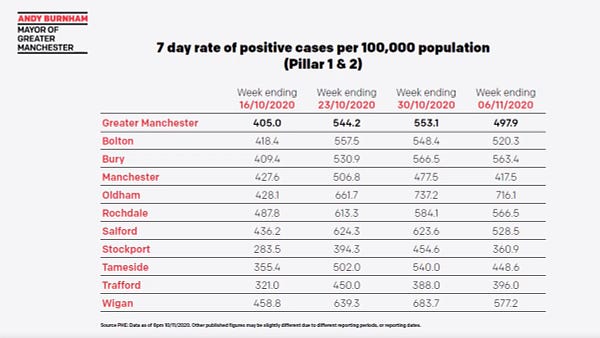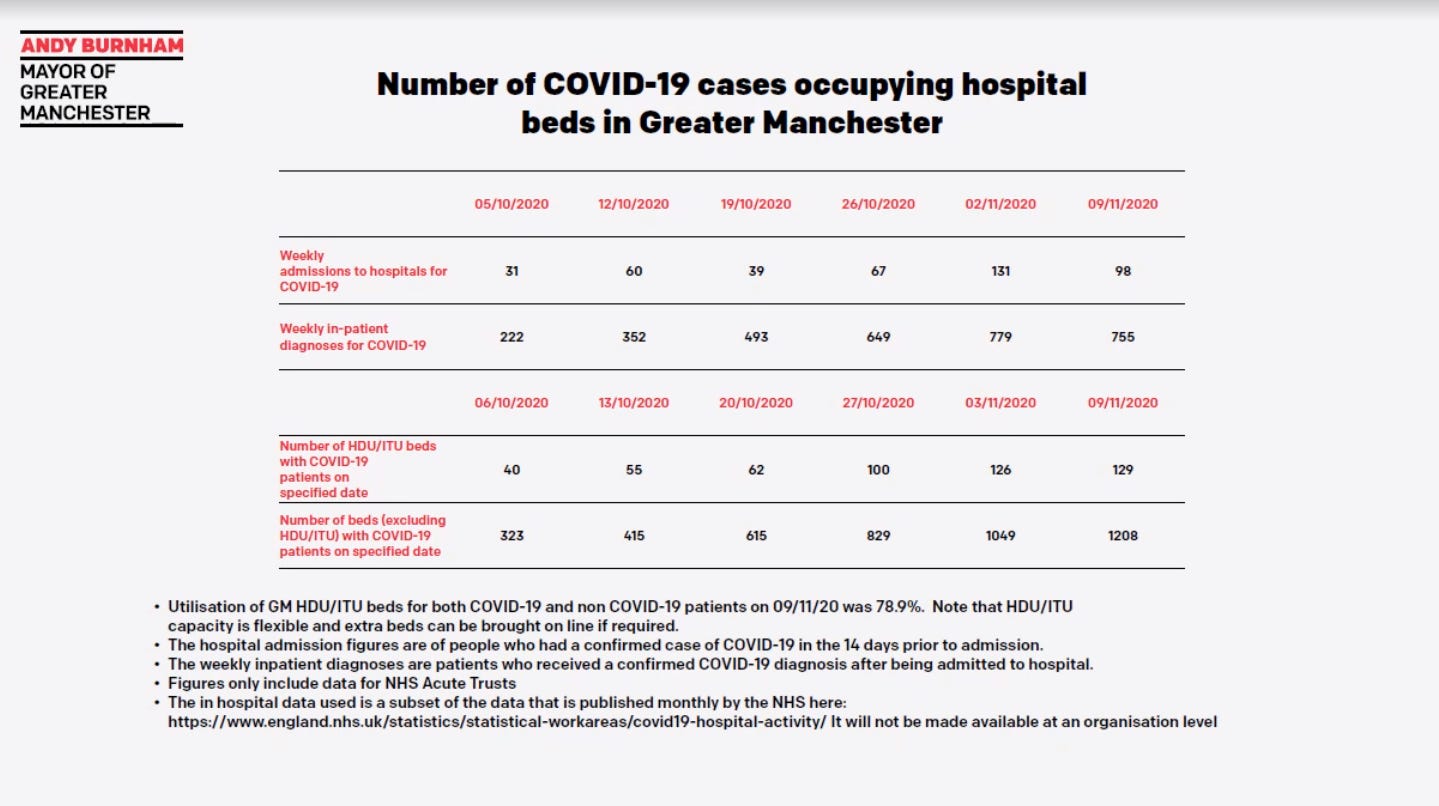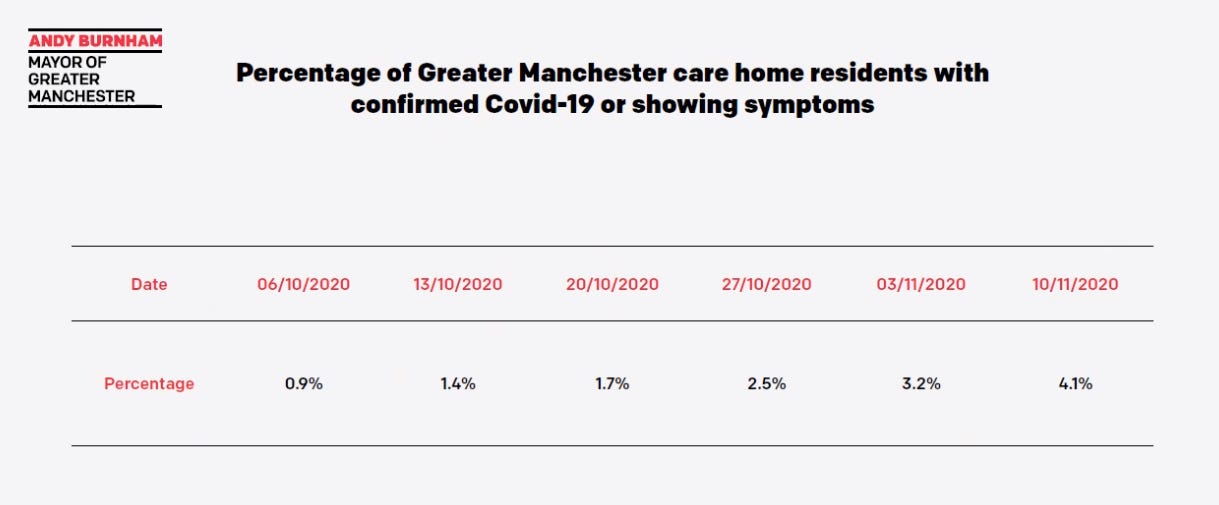'We may have seen the peak of the second wave' in Greater Manchester
Case rates are falling for the first time since August, as hospital admissions drop too
Good evening - this is a quick update on the latest Covid-19 situation in Greater Manchester, based on new data just released by Andy Burnham at his weekly press briefing.
For once, there’s some good news: infection rates and hospital admissions are falling. “We may have seen the peak of the second wave with regard to the number of new infections in the community,” Burnham told reporters. He warned that the pressure on hospitals hasn’t peaked yet, with the number of Covid patients in ICU beds (129) and in other hospital beds (1208) still rising.
Normally we send out the latest Covid data in our Monday briefings, but these new figures suggest we’ve reached an important moment in the second wave. There is sometimes a tendency in the media to report bad news very prominently and underplay good news because it won’t shock people or make them click, so we try to avoid that trap.
As ever if you think someone you know might find this briefing useful, interesting or reassuring, please do forward it to them or use the share button below.
Case rates are falling
For 11 long weeks, the Covid infection rate has been rising in Greater Manchester. Now, finally, we have a week-on-week drop. In the week ending last Friday, the GM rate (new cases per 100,000 residents) was 497.9, down 11% from 553.1 the week before. That’s still very high, but it’s the news we have been waiting for.
Rates have fallen in nine of the ten boroughs, while Trafford saw a very slight increase. Oldham still has by far the highest rate, at 716.1, while Stockport has the lowest with 360.9. You can see all the latest rates in the graphic below - and as always remember that rates are contingent on testing numbers so are only a rough indicator of the actual spread of the virus.
Crucially, infection rates are falling among the older age groups - down to 429 among over-65s compared to 464 at the end of October, and down significantly among the 45-64 age group from 790 to 609. Burnham called this “an encouraging sign”.


Hospital admissions are down
Last week there was naturally great concern when we learned that hospital admissions had doubled in a week. If that trend had continued, the pressure on hospitals could have become extremely serious very quickly. This week’s number (for the 7 days ending on Monday) is down on last week’s - from 131 to 98 admissions, a fall of 25%.
The number for in-patient diagnoses of Covid is also slightly down - from 779 to 755. This number (which includes patients who caught the disease in hospital and many that come in with Covid but don’t have a positive test at the time of their admission) has been a big part of the equation in the past month or so.
Patient numbers are still rising
The number of patients in critical beds (High Dependency Units and Intensive Therapy Units) was 129 on Monday, up very slightly from 126 the week before. The previous week it had risen 26%, so this week’s much smaller increase is a relief. Currently, 78.9% of these beds are in use (when you include non-Covid patients too), down from 84.2% last week, partly as a result of more beds being opened up.
The number of beds occupied by Covid patients outside of the critical care wards is now 1208, up from 1049 the week before. Hospitals are “finding it harder to discharge patients,” Burnham said, which leaves them with a lot of Covid patients in their wards and under quite a bit of pressure. This number has grown by roughly 200 per week for about a month now.
The mayor said the worst might still be to come when it comes to pressure on the health service. He told us:
Although there are the first signs perhaps that we may have seen the peak of the second wave with regard to the number of new infections in the community, I think it's important for me to say it doesn't yet appear we have reached the peak in pressure on our hospitals. And that is more likely to be felt towards the later part of this month - that's certainly what our colleagues in our hospitals are expecting to see. So we haven't, from an NHS point of view, seen the full impact of the second wave.
Cause for concern in care homes
There’s reason to be worried about the number of care home residents catching the virus. In early October the proportion who had a confirmed Covid diagnosis or were showing symptoms was 0.9%. That figure grew to 2.5% by the end of the month and has risen to 4.1% for the week ending yesterday.
How does this compare to the Spring, when the virus was ripping through care homes at an alarming rate? It’s hard to say because the number wasn’t calculated in April. We do know that it was 6.7% in early May, so we’re not at that level yet. But Burnham says it is a situation his team are watching closely.
Clearly for anyone in a care home or with a family member living in one, it must be extremely worrying to see that number tick up, and we know that cases in care homes are associated with higher mortality, for obvious reasons.
If you work in a care home or live in one and would like to confidentially feed some information into our reporting or tell us what you are seeing, please reply to this newsletter or email joshi@manchestermill.co.uk.
Before you go: We publish all of our reporting on the pandemic for free, so that anyone can access it. If you can afford to fund The Mill’s journalistic work by joining us as a member, please consider doing so today using the button below.
To our 500+ members: Thank you for your support and for being the very first patrons of a new high-quality news organisation in Greater Manchester.
Finally, a great read from our archives: David Barnett’s piece “I worked for the North West's local newspapers as they started to collapse: Reflections on a changing industry by a hack from Wigan.”
When it was first mooted that newspapers could actually have a presence online, I remember one old hack pointing at the big, beige monitor, keyboard, mouse, and system tower on his desk and quipping: “Well, I’m hardly going to take this lot into the bogs every morning for a quick read, am I?”






